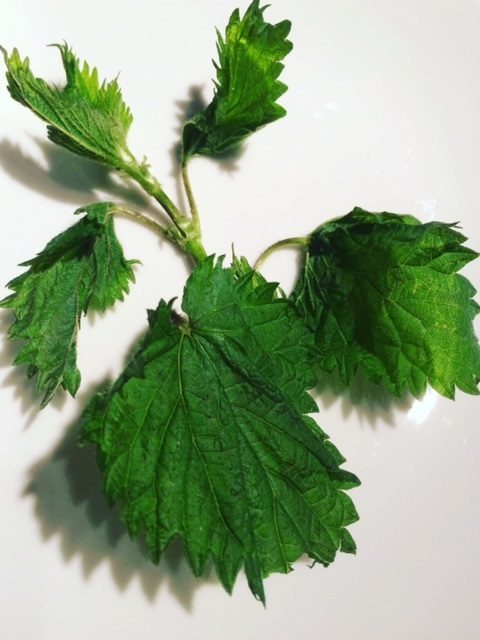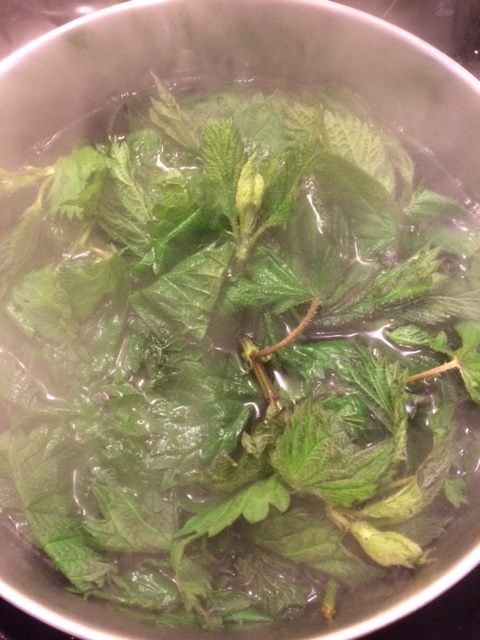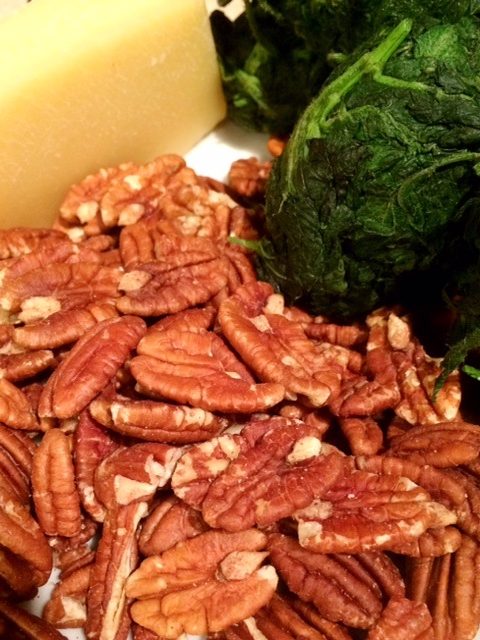One of my favorite signs of spring is stinging nettle! It’s easily foraged and from an herbal remedy standpoint, this super food is full of nutrients and minerals like fiber, calcium and iron. They may also help with allergies (of course, if interested in using nettles for herbal use, please check with your doctor first!). From a culinary perspective, it’s delicious and adds an amazing earthy flavor to soups, stews, breads, or my favorite: in place of basil for pesto. If you can get past the sting, you’ll have one of the best ingredients that spring has to offer!
Nettle Pesto
Makes 5 cups
Ingredients:
1.25 lbs nettle or 3 cups blanched, liquid squeezed out
1/2 lb pecans, roasted (you can substitute your favorite nut here as well, keeping the same weight.
1 head garlic, or 10 large cloves peeled
1 large lemon, squeezed
1/2 cup olive oil
4 ounces parmesan, grated
1/8 tspn pepper, or more to taste
1 pinch of salt, or more to taste (add after you blend in your parmesan, which tends to be salty)
1 pinch red pepper flake (optional)
Equipment needed:
Stock pot, or other deep pot
Cookie sheet
Food processor
Cheese grater
Tongs
Gloves
Process:
- Start by getting your water going-fill a deep pot 3/4 of the way up with water and set on the stove on high. You’ll use this to blanch your nettles which removes the sting.
- While that is heating up, you’ll start roasting your pecans. Lay them out in a single layer on a cookie sheet, place in the cool oven and turn it on to 300 degrees. Cook the pecans for 10-15 minutes, or until they are lightly toasted. As ovens vary, I would check them starting at 5 mins, and every 5 mins after until you can smell them and they are just starting to brown. Keep in mind they will continue to cook a little as they cool on the pan. Take them out and let them cool while you’re blanching your nettles.
- Prep your nettles by removing the leaves from the stems. This is where the gloves come in as the sting can be painful and can last some time. If some of the newer stems are still attached, that is fine; the goal is to have as much of the lower, woody materials removed. You can also blanch everything, stems and all, and then remove the leaves after, which is what I did. The blanching will take longer, but it will also reduce your sting risk!
- Using your tongs, place large bunches of nettle into the boiling water. Note: You want enough that this part doesn’t take forever, but not so much that the nettles clump up-you want the nettles to move around so that they blanch quickly.
- Let the nettles blanch for no more than 1 minute and remove to a colander to drain.
- Continue blanching and scooping until you’ve gone through all of your nettles. **Tip: You can save this infusion to drink!**
- Lay your blanched nettles on a clean, dry towel or cheesecloth and roll the cloth up, squeezing as much of the moisture out as you can. Too much liquid can ruin the end pesto!
- NOTE: If you have a smaller food processor, you’ll want to do this in two batches! Grab your food processor and add in your fully cooled pecans, and pulse until broken down into smaller pieces. You’ll be adding in other ingredients and don’t want to make butter, so don’t go crazy here!
- Add your cheese, pepper, red pepper (if using) and mix until it looks well distributed-usually a few good pulses
- Add your nettles and pulse to break those bad boys down.
- Add your lemon juice and pulse a few more times.
- This is where the magic happens! Grab your olive oil and turn your processor on-slowly pouring the oil in. If you prefer a drier, thicker pesto, stick with the amount of oil listed. If you prefer a smoother, creamier pesto, add more oil slowly until you reach the desired consistency. There’s no wrong way here and you’ve made it through the hardest part!
You’re probably thinking…why does she prefer a drier pesto? I add this stuff to everything-soups, sauces, eggs; you name it. If I want a formal pesto, I can add more oil to it later. I can’t take the oil out after the fact!
So there you have it, an easy pesto with an element of danger, or at least a good sting. What will you add your pesto to?
~Yours in earthy goodness~
Raina




[* Shield plugin marked this comment as “spam”. Reason: Failed GASP Bot Filter Test (checkbox) *]
I say tong-fulls because you do not want to pick up fresh nettles, as they will sting you.